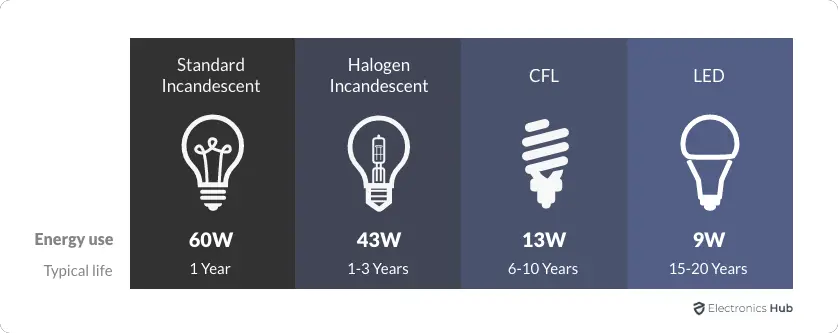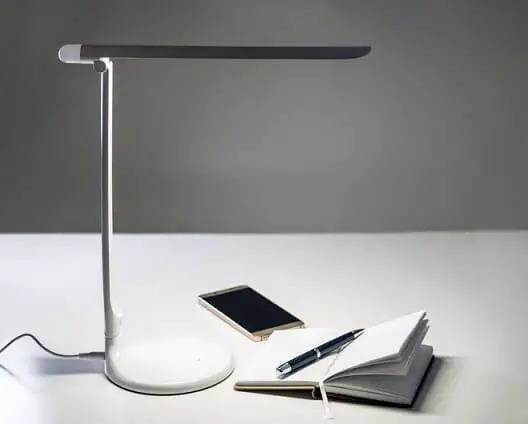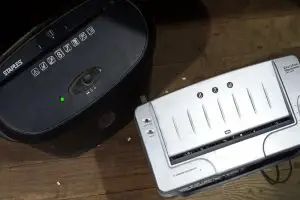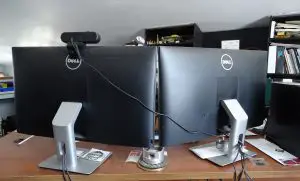We’ve all had the experience – staying up late to continue working on a work project or a school assignment but not wanting to keep anyone else in the house awake.
A light that fills the whole room feels like overkill, but the low light of your desk lamp is almost like a lullaby to your exhausted self. The fear of fire stops you from falling asleep and you wonder: can desk lamps catch fire?
A desk lamp, like any other electronic device, could catch fire under the right circumstances. However, this is extremely unlikely to happen. Aspects that may increase or decrease the risk of a fire include the type of light bulb used in the desk lamp and the integrity of the electrical wiring.
While there is always a chance of fire from electronics, taking the proper preventative measures to protect yourself and your home will drastically reduce those chances.
If you’re not familiar with the potential dangers of electricity, though, you may not know what to be preventing. We’ll discuss the most common causes of fire in lamps, how to avoid them, and more.
At Office Solution Pro, we are passionate about Ergonomics! Our readers support the page. If you click on a link, we may earn a small commission at no cost to you. We hope you love the products we recommend as much as we do!
What Causes Desk Lamps to Catch Fire?
Even though modern desk lamps are quite safe, there are still 7 billion people on the planet. This means that there will inevitably be some sort of fire caused by a desk lamp just by sheer odds. In fact, there are plenty of fires started by improper electrical and light safety every year.
Here’s some scenarios that could lead to a fire from your desk lamp:
- Falling asleep at your desk with the light still on, which may risk overheating the bulb on older lamps and causing it to short and catch fire.
- You may have stepped out of the house with your desk lamp still on for what you assumed would be a moment, only for it to last several hours.
- A piece of fabric or another material lie too close or atop the heated bulb, risking burning and starting a fire.
Modern desk lamps from trusted manufacturers are made to deal with these concerns, though, so there is no need to be paranoid. That being said, issues do still happen, so let’s explore two of the most common sources of fire from desk lamps.
Choices of Light Bulbs

There are four different light bulbs that you can choose from, including incandescent, halogen, CFL, and LED. Some of them rely entirely on heat to provide light, making them a significant liability if you happen to leave them on for too long.
Two of the most “dangerous” light bulbs for this concern are incandescent and halogen light bulbs.
Incandescent light bulbs Burn Very Hot
The Incandescent light bulb is some of the most common light bulbs to date, despite the fact they are also known to be some of the most inefficient. Incandescent light bulbs were the standard for most of the history of light bulbs, dating all the way back to the first successful one.
The way incandescent light bulbs work is they heat the filament inside the glass with the electricity provided to the bulb. As it heats it, the filament releases that energy in the form of photons (light).
Due to these light bulbs producing more heat than light, the bulb itself can get very hot. If something is resting against the bulb, there is a chance it will melt, burn, or catch fire.

Halogen light bulbs Are Better, But Still Not Great
A different type of incandescent light bulb, halogen light bulbs, conduct heat similar to the prior mentioned light bulbs but has a special method of its own that makes it unique. Halogen light bulbs use halogen gas and the halogen cycle to make the best out of their power.
Unlike their heated counterpart, halogen light bulbs are relatively effective and have a longer life than general incandescent light bulbs. This makes them a higher quality choice than the standard incandescent light bulbs, but it doesn’t eliminate the danger the light bulbs bring.
Faulty Wiring Can Cause Electrical Fires
Faulty wiring is one of the leading causes of house fires, leading to annual damages to households that can total up to one billion dollars. Whenever you are having issues with electricity, it may seem more like an inconvenience than an actual problem.
This isn’t right, however, as you will want to work as quickly as possible to ensure your home remains safe.
A faulty wire in the house, regardless of the location, is dangerous and needs to be taken care of quickly after discovery. If you do not take the opportunity to fix the electrical problem in your home, you could be looking at a fire that spread much further than your bed.
What Can I Do to Prevent A Desk Lamp Fire?
All of that being said, there are some precautions you can take to ensure that your desk lamp is operating safely and give you some peace of mind.
Keep Items Away from Light Source
If you are going to be keeping an incandescent or halogen light on without supervision, you need to guarantee there are no flammable objects on or around the light bulb.
If something is too close, such as a shirt, there is a possibility that the light bulb will cause it to burn. Due to this, the area around the light bulb and desk lamp should be cleared of anything that could become dangerous.
Check the Wattage of the Bulb
You may have issues with your light bulbs and potential fires if you are not using the appropriate wattage. If you do not consider the choice of wattage you are applying to a power source, you may be exceeding the maximum recommendation. This excess wattage can lead to your bulb overheating and causing a fire.
Keep an Eye Out For Wiring Issues
Always look for problems with the wiring of your home if you are afraid of fires. Listen for popping or sizzling noises inside your wall and check for loose power outlets, as well as:
- Wires with visible damage
- Any discoloration around outlets that may indicate burning
- The smell of something burning
- Lights dimming when using another appliance
- Your circuit breakers keep tripping their fuses
If you discover anything that seems harmful, shut the power to your home off and have a trained professional search for and solve the problem. This isn’t something you will want to fix yourself.
What Type of Light Bulb Is Safest?
An LED desk lamp.
This answer depends entirely on what your definition of “safe” is in terms of light bulbs. While some people may deem “safe” as not proposing a fire hazard, LED light bulbs are praised for the low temperature that they emit even after hours of use.
However, others want to be sure that they are using a light bulb that is safest for their eyes. In this case, incandescent light bulbs may be safest despite their extreme heat. This is because incandescent lights do not emit as much blue light as LED bulbs may.
Conclusion to Desk Lamp Fires
Anything using electricity can potentially be a source of fire if something goes wrong, such as faulty wiring inside your desk lamp. However, electric fires are quite rare and are not something you need to be paranoid about as long as you practice good electrical safety.
The choice of the light bulb, on the other hand, can make a large difference in the safety of the desk lamp. Incandescent bulbs give off that soft, calming glow that we’re all used to—but they can easily heat to unsafe levels and burn or melt things that accidentally touch them.
In the end, though, your desk lamp is not very likely to be the source of a serious fire, even though it could cause a fire. If you use an incandescent bulb, just make sure to keep things away from it and turn it off when you leave the house.








